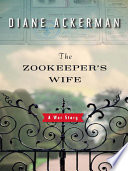When Germany invaded Poland, Stuka bombers devastated Warsaw—and the city’s zoo along with it. With most of their animals dead, zookeepers Jan and Antonina Zabinski began smuggling Jews into empty cages. Another dozen “guests” hid inside the Zabinskis’ villa, emerging after dark for dinner, socializing, and, during rare moments of calm, piano concerts. Jan, active in the polish resistance, kept ammunition buried in the elephant enclosure and stashed explosives in the animal hospital. Meanwhile, Antonina kept her unusual household afloat, caring for both its human and its animal inhabitants—otters, a badger, hyena pups, lynxes.
With her exuberant prose and exquisite sensitivity to the natural world, Diane Ackerman engages us viscerally in the lives of the zoo animals, their keepers, and their hidden visitors. She shows us how Antonina refused to give in to the penetrating fear of discovery, keeping alive an atmosphere of play and innocence even as Europe crumbled around her.
-
Sexual Content - 0/5
0/5
-
Violence - 3/5
3/5
-
Language - 1/5
1/5
-
Drugs and Alcohol - 0/5
0/5
Summary
The Zookeeper’s Wife tells the true story of Antonina and Jan Zabinski, a married couple who owned and ran the Warsaw Zoo in the 1930s. Jan was technically the zookeeper and had a passion for zoology, but Antonina had a particular affinity for dealing with some of the more difficult animal cases. When the Germans invaded Poland in the late 1930s, Antonina temporarily went into hiding, while Jan joined the Polish army, who put up a respectable fight but in the end didn’t win. After their defeat, Jan was able to return home, and after locating Antonina, the pair returned to their zoo. Unfortunately many of the animals had been killed in the bombings, and of those that survived, several more were confiscated by the Germans to be sent to Germany. Sadly most of the remaining animals were brutally slaughtered by German soldiers using them for target practice. Antonina and Jan then joined the Polish Underground and for the next several years used their connections and their now-empty zoo to hide Jews and help them escape Warsaw. They’re credited with saving over three hundred souls as part of a one-of-a-kind mission code-named Zagota. When it seemed they might be able to get the upper hand on the Germans, Jan went back to fighting with the Polish Resistance. Although they didn’t initially win and Jan was sent to a concentration camp while Antonina once again went into hiding in the countryside, eventually Poland was freed from Nazi control. Following the war, Jan and Antonina reunited and rebuilt the zoo, but possibly due to political pressures from the Soviets who now controlled the country, they eventually left zoo life for other pursuits.
I have a strong interest in WWII history, especially the survival stories, which is why The Zookeeper’s Wife landed on my TBR list. It’s an interesting account of these unsung heroes who I hadn’t previously heard of. Jan was a bold, courageous, risk-taker, and while Antonina was more reserved, she was no less brave in her own way. Not only did she run a large household and save many lives, but she also gave birth in the midst of all the turmoil after enduring a difficult pregnancy that kept her bedridden for much of the time. I was saddened by everything their son, Rys, had to go through at such a young age, losing beloved pets, while having his life threatened more than once, but he too showed courage in wanting to fight back against their oppressors. There were a number of interesting people who came and went from the zoo grounds, some of whom lived and hid in the large house they called the villa for extended periods of time. I can only imagine what life must have been like for them, first running from bombs and wartime fighting, then under the constant risk of being shot without trial if they’d ever been found harboring Jews. Their Underground way station was code-named “The House Under the Crazy Star” and in many ways that was an apt designation, given all the unusual things that happened there. Jan and Antonina’s family in many ways seemed to be quite lucky in that they survived a number of dangerous and life-threatening circumstances, including Jan being shot through the neck and German soldiers nearly killing Rys. Because of her ability to help troubled animals, Jan thought that Antonina had a psychic connection with all living things that extended to other human beings as well, and given the way that she was able to talk down cruel German soldiers, I couldn’t necessarily disagree. This family went through a lot and that they came out the other side intact is a testament to their courage and strength.
While The Zookeeper’s Wife told an interesting WWII tale that I hadn’t heard before, it ultimately wasn’t quite as compelling of a story as I thought it should have been, which is why I dropped the star rating. When I read that Diane Ackerman was a naturalist by trade, I thought that was an odd choice of someone to write a war story, even one that takes place in a zoo (albeit one that’s been decimated by war), and I felt like that was borne out in her writing style. We don’t even learn a lot about the Zabinskis, their personalities, or backgrounds until quite a ways into the book. For about the first half of the story, the author would often tell a little about them, and then veer off for long passages or even full chapters discussing other peripheral characters who had some connection to the Zabinskis but who weren’t necessarily deeply involved in the real meat of their story. These parts just didn’t interest me all that much. The author’s background as a naturalist also came through in her detailed descriptions of animals, plants, the environment, and other nature aspects, which in a different book might have been welcome, but what I really wanted was for her tell more of what was happening from day-to-day in the villa and in the Zabinskis lives. Finally around the halfway mark, she delves into this more, and I was able to become better engaged in the story. It’s not that Ms. Ackerman is a bad writer. She uses some truly lovely turns of phrase. It was that the story seemed to lack focus early on and even when she did start centering the narrative more on the Zabinskis and their “Guests,” I still didn’t feel like it went as deeply as it could have. Overall, I’m glad that I read The Zookeeper’s Wife, as it gave me a little insight into a previously unknown piece of history, but I still felt like the book could have been better. Hopefully the movie version will prove more compelling.
Review provided by The Hope Chest Reviews

